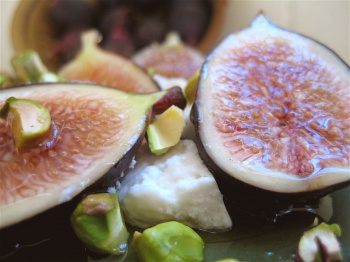Cleopatra took her own life with the bite of a snake hidden in a basket of figs.
And then, of course, there is the penchant of likening the fig to a certain part of the female anatomy, which may or may not be a bad thing, depending on your point of view. Fortunately, the reputed First Woman found that a large leaf from the fig tree would do nicely in concealing hers.
A Little Bit of History.
The fig is ancient. Remnants of the fruit have been found in excavations dating from 5,000 B.C.E. in Western Asia Minor. The tree and it's fruits quickly spread around the Mediterranean.
Demeter gave them to Dionysus. Plato mentioned that Greek athletes were fed on a diet of them to increase their strength and speed. Temporarily. Figs contain a high concentration of sugar (up to 50%). Think of them as ancient Power Bars. Jesus, in a fit of ungodly pique (Matthew 21:18), cursed a fig tree for not producing any fruit for Him as He passed by, thus killing the tree and ensuring there would be no second chances for it. Unless, that is, He chose, in His infinite goodness, to resurrect it at a later time.
The leaves of the tree have been used to provide shade, wrap food, and hide the naughty parts of statues. The tree itself was an easy source of quick-lighting firewood.
The fig is one of only five fruits mentioned in the Quraan along with olives, grapes, pomegranates, and dates. That's some good company.
Eat Them While You Still Can
Unpleasant associations aside, figs are inherently good on the inside. They are high in fiber, yet according to the ancient Egyptians, have a mild laxative quality to them.
They are rich in calcium, iron, phosphorus, and potassium. Less so in Vitamin C and B vitamins, but they are sourced there, too.
Figs are excellent dried, stewed, or eaten raw. They add a subtle depth to sweet dishes, and sweetness to savory ones.
How anyone could see their way to giving this simple fruit, one which exudes such sweetness, sexual suggestion, and history with every mouthful, is beyond me. And frankly, I simply couldn't give a fig about this poor fruit's detractors.
I shall think no more about it. Instead, I plan to continue making myself sick on them until the season is over.

Fig Salad
I like this preparation because it basic-- if not as old as the hills, it is possibly older than the Bible. All the ingredients have been in common use in and around the Mediterranean for more than 7,000 years. That's about 1,000 older than the earth itself, according to Young Earth creationists.
I am not giving specific amounts for any of the ingredients because that would complicate such a perfectly simple dish. The amount of each ingredient is entirely up to your preference.
Serves as few or as many as you wish.
Ingredients:
Ripe figs, well washed, to reduce the risk of poisoning from scheming Roman matrons.
Any soft, faintly salty sheep or goat milk cheese at room temperature. Goat cheese will add a wonderful tang to the dish, while sheep’s milk lends a certain umami to the overall outcome. I do not recommend cow's milk cheese-- it's just not biblical.
Olive oil. Extra virgin.
Honey. I prefer mine warmed. If one replaces the period with a comma in this last sentence, the meaning is very much changed.
Chopped pistachios. Or almonds. Your choice.
Preparation:
Wash the figs well, dry and bisect. Place them on a serving dish with the cheese which you have broken into reasonably attractive chunks. Drizzle figs and cheese with olive oil and honey. Sprinkle dish with chopped nuts to garnish. Eat.
 I love figs. They're on the short list of my favorite things, so I have always had difficulty with the phrase "I couldn't give a fig." The meaning of the phrase, of course, is that to give a fig is to care little. To not give a fig means to care even less. Of course, the true purpose of the word "fig" in that phrase is commonly thought to be as a replacement for another, unprintable-on-this-website "f" word. And that depresses me. It's given the fig a bad name.
I love figs. They're on the short list of my favorite things, so I have always had difficulty with the phrase "I couldn't give a fig." The meaning of the phrase, of course, is that to give a fig is to care little. To not give a fig means to care even less. Of course, the true purpose of the word "fig" in that phrase is commonly thought to be as a replacement for another, unprintable-on-this-website "f" word. And that depresses me. It's given the fig a bad name.